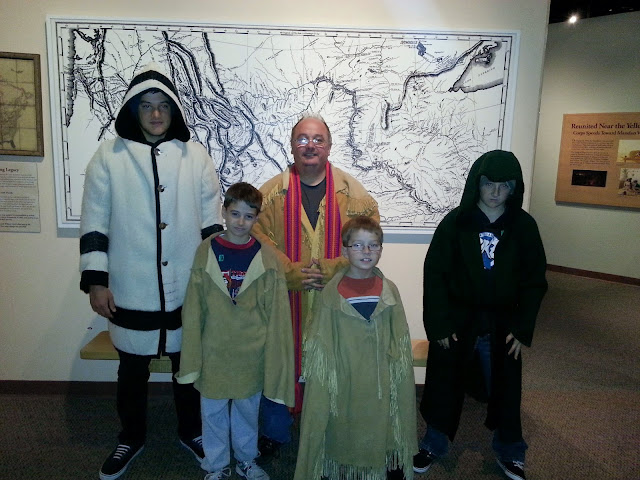On Friday, April 11th, we found our way to Great
Falls, Montana, by way of the Blackfeet Nation in central Montana. We intended to stay at the Air Force base in
Great Falls, but their campground was still closed for the season. We found an open commercial campground and
decided to stay for two nights because of the impending snowstorm that was
approaching. Apparently many other
people had the same idea. I think we
were the only ones at the campground who weren’t “snowbirds” from Alberta!
On Saturday we decided to take in a few things that Great Falls
has to offer to tourists. Even though
the weather was cold and it was snowing all day long, we still managed to find
our way to the Lewis & Clark National Historic Trail Interpretive
Center. I had expected this to be a
quick visit, but we were pleasantly surprised by the impressive exhibits and
the sheer size of the museum. They had a
“Junior Explorer” program that the younger kids did, and we even watched two different
short movies in the movie theater about the Corps of Discovery Expedition by
Lewis & Clark. One of the movies was
a Ken Burns film.




In 1803 President Thomas Jefferson purchased the Louisiana
Territory from France. This land
acquisition essentially doubled the size of the United States. However, before settlement could take place
in this uncharted land, the area had to be mapped out and relations had to be
established with the natives who lived in this land. Furthermore, the Northwest Passage (the mythical
water pathway that would connect the Atlantic and Pacific Oceans) hadn’t yet
been discovered, and citizen settlers would secure the area for the United States. Thomas Jefferson commissioned Meriwether
Lewis and William Clark to lead the Corp of Discovery in an unprecedented
expedition to explore the newly acquired territory. Of course, the expedition would have failed
had it not been for their Shoshone Indian guide Sacagawea. The purchased territory would later become all
or part of 15 states and two Canadian provinces.





Most of their journey was by water until they reached the
land that would become Montana. The
river had five separate waterfalls, so the team had to portage around the river
for eighteen miles. They thought it
would take half of a day, but it ended up taking them two weeks! It was an arduous journey which included heat
stroke, lemon-sized hail, foot infections from prickly-pear cactus needles,
etc. But eventually the corps did
complete their portage around the area of Great Falls, reaching the Rocky
Mountains and eventually the Pacific Ocean.


(The story of the Lewis & Clark expedition is truly
amazing. It is one of Steve’s favorite
episodes in history. If you aren’t
familiar with its particulars, I encourage you to investigate. It’s a fascinating story!)


After our time at the interpretive center, we drove to the
Rainbow Falls of the Missouri River, which is very much changed from the time
of Lewis & Clark. Nowadays the river
is dammed and a hydroelectric plant creates electricity for the area
population. We were going to try driving
to see some of the other falls on the river, but the snow was still falling and
we thought it would be best to stay on the main roads.

After we saw the waterfall and grabbed a bite to eat at a
fast food restaurant, we drove to another area attraction: First Peoples
Buffalo Jump State Park. I suppose
because the weather was bad and it was still the off-season, but we pretty much
had the place to ourselves. The visitor
center had a nice museum with static displays of the buffalo hunt as the
natives would do it, and we had a private presentation by a park ranger about
the methodology of the buffalo hunt.

From 900 to 1500 AD, Indian tribes from all over the area
would hunt the buffalo near this area. They
would round up a herd and corral the herd toward a cliff by disguising
themselves as wolves (in the back of the herd) or as a distressed bison calf
(in the front of the herd). Because
bison are near-sighted, once they started stampeding toward the edge of the
cliff, they couldn’t see the danger until it was too late. In one hunt, enough bison could be killed to
feed an entire tribe (sometimes two tribes) for an entire winter season – which
is LONG in Montana! It is claimed that
this was the most efficient hunting method in the history of mankind, as
hundreds of bison were killed in one hunt.






At the state park, archaeologists have uncovered a depth of
12 to 18 feet of bison bones at the base of the cliff, along with some
arrowheads and other First Nations artifacts.
The cliff is about one mile long, and we tried to drive up to it, but
our van just couldn’t maneuver on the snow-covered dirt and gravel steep
road. It was too slippery for us! So instead we just headed back home.

That night we encountered our coldest night yet in the
camper - 14 degrees! Brrr!
The snow never stopped that day, and we accumulated more than an inch of
snow. However, the snow wasn’t as much
of an issue as the ice was. Our
slide-out rooms on our camper had frozen open during the night. In order to leave the next morning Steve had
to chip away all the ice on the tops of the slide-outs - a slow and tedious
task – in order for us to be able to break free, close up the camper, and roll
away. Eventually we did manage it, and
we left Great Falls to continue our journey across the country.
